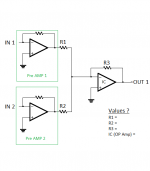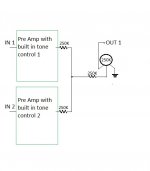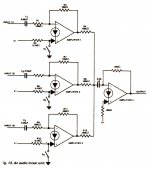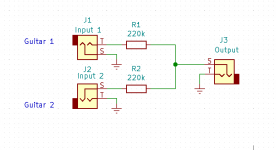I have a nice Fender Champion 40 amp and am thinking of making a mixer so that I can plug 2 guitars into the amp's single channel. I found a very simple mixer using only 2 pots and 2 resistors. All 4 having a value of 250K.
Then I started thinking of trying to hook a VU meter up and found better mixer schematics using op amps. I have attached all of the circuits that I have been looking at.
My main question is what would be the best way to run 2 guitars with passive pickups into one amp input jack and be able to control the density of sound coming from both guitars independently? Then add a master gain or volume on the output of the mixer rather than playing with the amp volume.
I am thinking that the easiest way would be a few $5 op amp boards that are prebuilt and a few pots to control them, but would I need resistors or caps in between?
Pretty lost here and thinking way too much. Any advice would be great! Thanks
Then I started thinking of trying to hook a VU meter up and found better mixer schematics using op amps. I have attached all of the circuits that I have been looking at.
My main question is what would be the best way to run 2 guitars with passive pickups into one amp input jack and be able to control the density of sound coming from both guitars independently? Then add a master gain or volume on the output of the mixer rather than playing with the amp volume.
I am thinking that the easiest way would be a few $5 op amp boards that are prebuilt and a few pots to control them, but would I need resistors or caps in between?
Pretty lost here and thinking way too much. Any advice would be great! Thanks
Attachments
Since you already have a volume pot inside each guitar, the very simplest mixer you can make only needs two fixed resistors, both of them 220k. I drew up the schematic for you, and attached it below. This assumes you know how to solder, and have the tools to do so.I found a very simple mixer using only 2 pots and 2 resistors. All 4 having a value of 250K.
No mixer is perfect, and this one is no exception. It's chief good point is extreme simplicity. I will let you discover its chief bad points yourself, as a learning exercise.
Keep in mind that mixers tend to use lots of 1/4" jacks, potentiometers, op-amps, and knobs. You'll also need a power supply, and an enclosure. You'll find the prices of all these components start to add up rapidly.
Sooner or later you may decide that you also want to add a microphone or two, to your two guitars for vocals, and a VU meter to see what's going on, and so on. As the circuit requirements become more complex, pretty soon it will be cheaper and more efficient to just buy a small commercial mixer, something like a Behringer Mix 5.
Commercial mixers like this are also not ideally suited to mixing guitars (can you find out why?). But they will work for the job, and are the easiest way to add a vocal microphone, for example.
I would like to help, but the starting point is to teach yourself some electronics, so you have a better understanding of what you want, and what the pros and cons are. For example, what is better about using op-amps? What are the weaknesses of the two-resistor mixer?...hook a VU meter up...better mixer...op amps...pretty lost
There are quite a lot of electronics resources available online these days, so I don't think you'll have too much trouble locating good information. Just stay away from "audiophile" forums and audiophile schematics, because there is a lot of complete nonsense in those camps, and right now, you won't be able to tell the BS from the good information.
For example, the six textbooks (all free) in this series are excellent. Depending on your existing technical background, it mightl take you a while to study your way through each one, but if you want to understand electronics, it will be well worth it: Textbook for Electrical Engineering & Electronics
-Gnobuddy
Attachments
Use them to adjust the relative balance of the two individual guitars in the mix. Use the guitar amplifier's own gain and volume controls to set overall loudness of the mix.I did not even think about the pots in the guitars
The volume pot in the guitar is not that useful with most solid-state guitar amplifiers, which usually don't respond much to the guitar signal - they sound the same whatever you do with the guitar volume knob. But if you use a tube guitar amp that's set correctly, you'll find that the sound of the entire amplifier can be varied a great deal using only the guitar's own volume control.
Joe Bonamassa gives an excellent demonstration of this here: YouTube
-Gnobuddy




